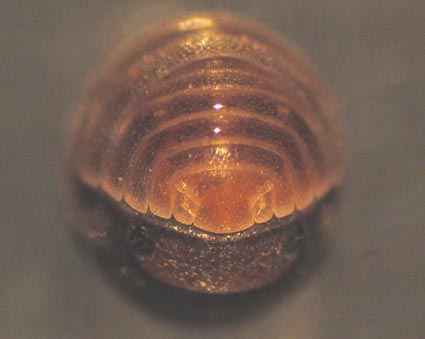
BUGS CLUB
Let's look for Pill Bug! (For Adults. Used for Nature Interpretation Seminar)

A pill bug in forrest!
Objectives:
1.Experience how you can let people feel close to nature by using insects as representatives since they account more than 60%of living creatures in the earth. This time, you will do a simple research about pill bugs, a soil animal. This will in the end let people find more interested in nature of area they live.
2.Look for pill bugs so that you can develop expertises in ecology and ethology of insects. Look closely at sowbugs you find. With those experiences, let people feel interested in the observations, and continuously look at nature around you.
3.Experience importance and enjoyment of in-depth observations of nature by doing a simple reseach activity.
Focus on the experiences. Then, people can start their own program development by themselves after they go back home.
Procedure:
1.What is Nature Watching of Insects? (Where is insect located in the animal genealogical tree? Distributions of insects? What are the objectives of insect searching and observations?)
2.How can you find pill bugs? ( you feel fun to find insects.)
3.Let's do it!
4.Reflection. (What did you learn by looking for pill bugs and by making close observatoins? Did you find anything? Think about relationships between pill bugs and you. How would you do when you play a role of facilitator?
5.Summary of program development and actual guides. (Encourage doing by yourself. Share references.)
Materials:
| □ Leaflet | □ Summary of Program Development and Actual Guides |
| □ Guide Board | □ Scoop, bucket, Plastic Tray, forceps, magnifying lens etc. |
| □ Microscope, magnifying lens, sowbugs maze | □ Desk |
Classification:
Armadillidium vulgare:
Arthropoda
Malacostraca
Isopoda
Armadillidiidae
A. vulgare
Venezillo dorsalis:
Arthropoda
Malacostraca
Isopoda
Armadillidae
V. dorsalis
Millipede belongs to Diplopoda, Centipede belongs to Chilopoda so they are already different at Class. Shrimp and Crab belongs to the same Malacostraca Class. Wharf Roach also belongs to Malacostraca.
Others in Isopoda you may see:
Mongoloniscus
Ligidium japonicum
The activity was performed:
At Interpreter Seminar by NACS-J at Rokko Mt. YMCA on Nov 23rd to 25th, '07:
Copyright © 2002 - 2017 むしむしくらぶ BUGS CLUB All Rights Reserved